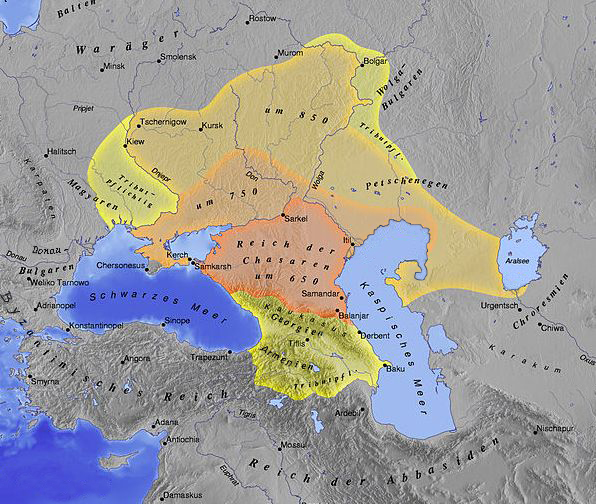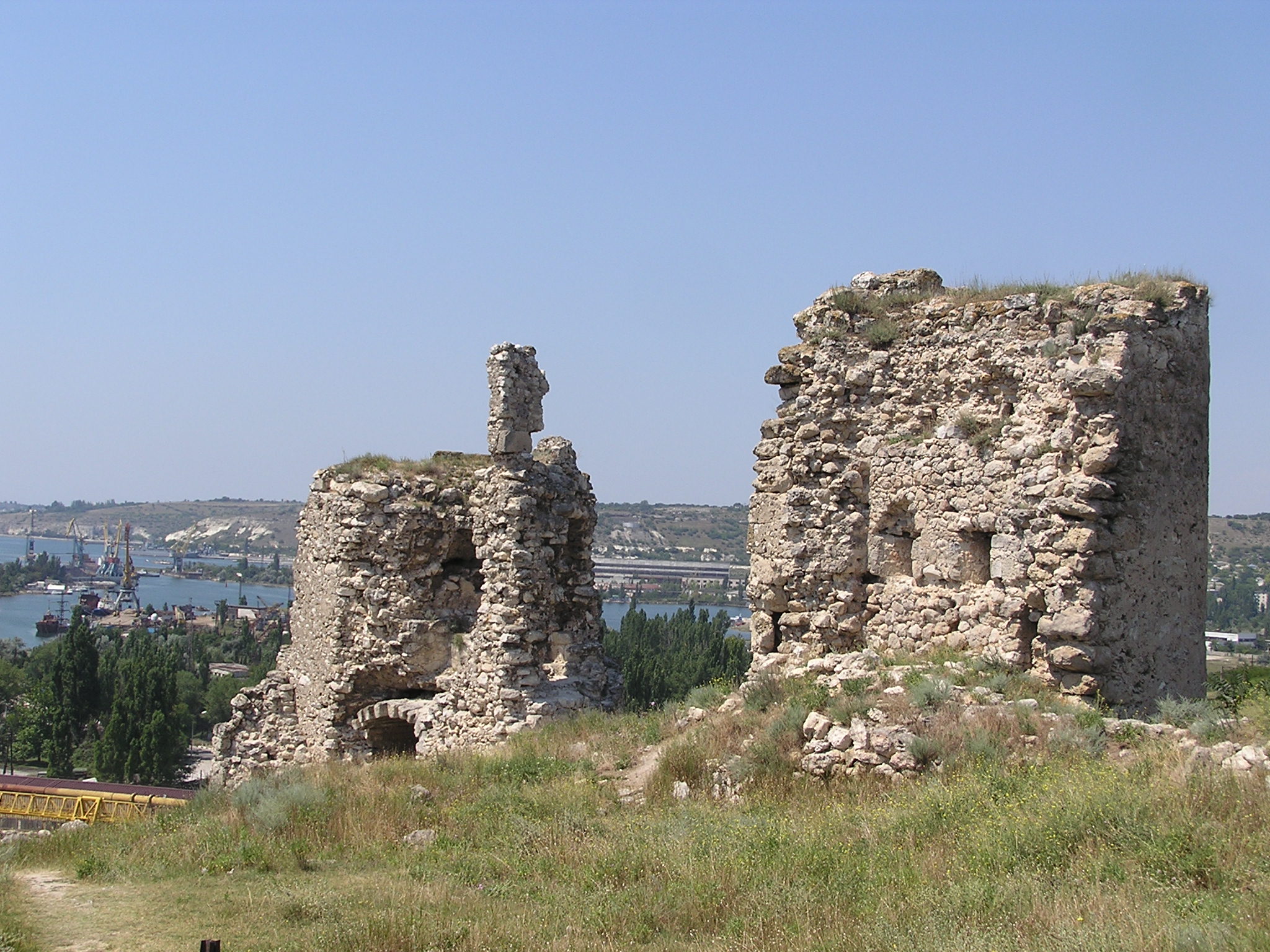|
Ghisolfi
De Ghisolfi (also known as de Guizolfi, de Gisolfi, Guigursis, Guilgursis and Giexulfis) was the name of a Genoese-Jewish family prominent in the late Middle Ages and the early Renaissance. In 1419, the Genoese Jew Simeone de Ghisolfi married a reigning princess of the municipality of Tmutarakan on the Taman Peninsula named Bikhakhanim, and took possession of this area, most likely centred on the town of Matrega. The de Ghisolfi clan ruled this principality as a protectorate of the Genoese consulate of Gazaria for much of the 15th century. In 1453, the Republic of Genoa ceded its Crimean possessions to the Bank of St. George, a private enterprise to which it was heavily in debt. The Ghisolfi family continued to rule Matrega and the surrounding region on behalf of the Bank. Through such intermediaries as Khozi Kokos, they maintained relations with the rulers of Muscovy and other Russian principalities. Zacharias de Ghisolfi A descendant of Simeone, Zacharias de Ghisolfi ... [...More Info...] [...Related Items...] OR: [Wikipedia] [Google] [Baidu] |
Bank Of Saint George (Genoa)
The Bank of Saint George ( it, Casa delle compere e dei banchi di San Giorgio or informally as ''Ufficio di San Giorgio'' or ''Banco'') was a financial institution of the Republic of Genoa. It was founded in 1407 to consolidate the public debt, which had been escalating due to the war with Venice for trading and financial dominance. The Bank's primary mission was to facilitate the management of the San Giorgio shares (''luoghi''). It was one of the oldest chartered banks in Europe and of the world. The Bank's headquarters were at the Palazzo San Giorgio, which was built in the 13th century by order of Guglielmo Boccanegra, uncle of Simone Boccanegra, the first Doge of Genoa. Operations Its parent, Casa di San Giorgio administered the Bank, and needed frequent liquidity injection to support the war against Venice and Genoa's ailing public finance. By 1445, the Bank suspended operations focusing on servicing the Genoese state. However, it managed to reopen for business with the ... [...More Info...] [...Related Items...] OR: [Wikipedia] [Google] [Baidu] |
Tmutarakan
Tmutarakan ( rus, Тмутарака́нь, p=tmʊtərɐˈkanʲ, ; uk, Тмуторокань, Tmutorokan) was a medieval Kievan Rus' principality and trading town that controlled the Cimmerian Bosporus, the passage from the Black Sea to the Sea of Azov, between the late 10th and 11th centuries. Its site was the ancient Greek colony of Hermonassa ( grc, Ἑρμώνασσα) founded in the mid 6th century BCE, by Mytilene (Lesbos), situated on the Taman peninsula, in the present-day Krasnodar Krai of Russia, roughly opposite Kerch. The Khazar fortress of Tamantarkhan (from which the Byzantine name for the city, Tamatarcha, is derived) was built on the site in the 7th century, and became known as Tmutarakan when it came under Kievan Rus control. History The Greek colony of Hermonassa was located a few miles west of Phanagoria and Panticapaeum, major trade centers for what was to become the Bosporan Kingdom. The city was founded in the mid-6th century BCE by Mytilene (Lesbos), al ... [...More Info...] [...Related Items...] OR: [Wikipedia] [Google] [Baidu] |
Taman Peninsula
The Taman Peninsula (russian: Тама́нский полуо́стров, ''Tamanskiy poluostrov'') is a peninsula in the present-day Krasnodar Krai of Russia, which borders the Sea of Azov to the North, the Strait of Kerch to the West and the Black Sea to the South. History The area has evolved over the past two millennia from a chain of islands into today's peninsula. In ancient times the peninsula was known to the Greeks as ''Sindikè chersònesus'' (Greek: Σινδική χερσόνησος, peninsula of the Sindi) and Pontic Greek colonies of Hermonassa and Phanagoria stood on the peninsula, as did the later city of Tmutarakan."Greek colonization in the northern Black Sea area" German Archaeological Institute. ... [...More Info...] [...Related Items...] OR: [Wikipedia] [Google] [Baidu] |
Bikhakhanim
Bikhakhanim (d. after 1419), was the reigning princess of a small polity located on the Taman Peninsula in southern Russia. She may have been of Circassian, Georgian, or Cuman origin. The Russian historian F. K. Brun, suggests that the name of the princess might not have been "Bikhakhanim," but "Bikhakhatun," and that, if so, she was the daughter of the Georgian prince Beka II Jakeli (died 1391), the ruler of Samtskhe and Klarjeti.Brosset ii. 206. However, "Beki" means "Ruling Woman" in Mongolian and "Khanim" was the Medieval title of a female patrilineal descendant of Genghis Khan (equivalent to "Khan" for a male). 1419 was the year that the sons of Tokhtamysh Khan of the Golden Horde killed his rival Edigu the Khan of the Nogai Horde as a continuation of the Tokhtamysh–Timur war and reestablished control over the region. Bikhakhanim was married in 1419 to the Genoese Jew Simeone de Guizolfi, who through this marriage became ruler of that country under Genoese overlor ... [...More Info...] [...Related Items...] OR: [Wikipedia] [Google] [Baidu] |
Matrega
Phanagoria ( grc, Φαναγόρεια, Phanagóreia; russian: Фанагория, translit=Fanagoriya) was the largest ancient Greek city on the Taman peninsula, spread over two plateaus along the eastern shore of the Cimmerian Bosporus. The city was a large emporium for all the traffic between the coast of the Maeotian marshes and the countries on the southern side of the Caucasus. It was the eastern capital of the Bosporan Kingdom, with Panticapaeum being the western capital. Strabo described it as a noteworthy city which was renowned for its trade. It was briefly a Catholic Metropolitan Archdiocese while a medieval Genoese colony under the name Matrega, it remains a Latin Catholic titular see. Today the site is located at a short distance to the west of Sennoy in Krasnodar Krai, Russia. Another ancient Greek city, Hermonassa, lies to the west, on the shoreline of modern Taman. History Antiquity Phanagoria was founded ca. 543 BC by the Teian colonists who ... [...More Info...] [...Related Items...] OR: [Wikipedia] [Google] [Baidu] |
Taman Peninsula
The Taman Peninsula (russian: Тама́нский полуо́стров, ''Tamanskiy poluostrov'') is a peninsula in the present-day Krasnodar Krai of Russia, which borders the Sea of Azov to the North, the Strait of Kerch to the West and the Black Sea to the South. History The area has evolved over the past two millennia from a chain of islands into today's peninsula. In ancient times the peninsula was known to the Greeks as ''Sindikè chersònesus'' (Greek: Σινδική χερσόνησος, peninsula of the Sindi) and Pontic Greek colonies of Hermonassa and Phanagoria stood on the peninsula, as did the later city of Tmutarakan."Greek colonization in the northern Black Sea area" German Archaeological Institute. ... [...More Info...] [...Related Items...] OR: [Wikipedia] [Google] [Baidu] |
Genoa
Genoa ( ; it, Genova ; lij, Zêna ). is the capital of the Italian region of Liguria and the List of cities in Italy, sixth-largest city in Italy. In 2015, 594,733 people lived within the city's administrative limits. As of the 2011 Italian census, the Province of Genoa, which in 2015 became the Metropolitan City of Genoa, had 855,834 resident persons. Over 1.5 million people live in the wider metropolitan area stretching along the Italian Riviera. On the Gulf of Genoa in the Ligurian Sea, Genoa has historically been one of the most important ports on the Mediterranean Sea, Mediterranean: it is currently the busiest in Italy and in the Mediterranean Sea and twelfth-busiest in the European Union. Genoa was the capital of Republic of Genoa, one of the most powerful maritime republics for over seven centuries, from the 11th century to 1797. Particularly from the 12th century to the 15th century, the city played a leading role in the commercial trade in Europe, becoming one o ... [...More Info...] [...Related Items...] OR: [Wikipedia] [Google] [Baidu] |
Circassians
The Circassians (also referred to as Cherkess or Adyghe; Adyghe and Kabardian: Адыгэхэр, romanized: ''Adıgəxər'') are an indigenous Northwest Caucasian ethnic group and nation native to the historical country-region of Circassia in the North Caucasus. As a consequence of the Circassian genocide, which was perpetrated by the Russian Empire in the 19th century during the Russo-Circassian War, most Circassians were exiled from their homeland in Circassia to modern-day Turkey and the rest of the Middle East, where the majority of them are concentrated today. The Unrepresented Nations and Peoples Organization estimated in the early 1990s that there are as many as 3.7 million Circassians in diaspora in over 50 countries. The Circassian language is the ancestral language of the Circassian people, and Islam has been the dominant religion among them since the 17th century. Circassia has been subject to repeated invasions since ancient times; its isolated terrain coupled wi ... [...More Info...] [...Related Items...] OR: [Wikipedia] [Google] [Baidu] |
Tatar
The Tatars ()Tatar in the Collins English Dictionary is an umbrella term for different Turkic ethnic groups bearing the name "Tatar". Initially, the ethnonym ''Tatar'' possibly referred to the . That confederation was eventually incorporated into the when unified the various steppe tr ... [...More Info...] [...Related Items...] OR: [Wikipedia] [Google] [Baidu] |
Slavs
Slavs are the largest European ethnolinguistic group. They speak the various Slavic languages, belonging to the larger Balto-Slavic branch of the Indo-European languages. Slavs are geographically distributed throughout northern Eurasia, mainly inhabiting Central and Eastern Europe, and the Balkans to the west; and Siberia to the east. A large Slavic minority is also scattered across the Baltic states and Central Asia, while a substantial Slavic diaspora is found throughout the Americas, as a result of immigration. Present-day Slavs are classified into East Slavs (chiefly Belarusians, Russians, Rusyns, and Ukrainians), West Slavs (chiefly Czechs, Kashubians, Poles, Slovaks and Sorbs) and South Slavs (chiefly Bosniaks, Bulgarians, Croats, Macedonians, Montenegrins, Serbs and Slovenes). The vast majority of Slavs are traditionally Christians. However, modern Slavic nations and ethnic groups are considerably diverse both genetically and culturally, and relations between them � ... [...More Info...] [...Related Items...] OR: [Wikipedia] [Google] [Baidu] |
Ducats
The ducat () coin was used as a trade coin in Europe from the later Middle Ages from the 13th to 19th centuries. Its most familiar version, the gold ducat or sequin containing around of 98.6% fine gold, originated in Venice in 1284 and gained wide international acceptance over the centuries. Similarly named silver ducatons also existed. The gold ducat circulated along with the Florentine florin and preceded the modern British pound sterling and the United States dollar. Predecessors The word ''ducat'' is from Medieval Latin ''ducalis'' = "relating to a duke (or dukedom)", and initially meant "duke's coin" or a "duchy's coin". The first issue of scyphate billon coins modelled on Byzantine ''trachea'' was made by King Roger II of Sicily as part of the Assizes of Ariano (1140). It was to be a valid issue for the whole kingdom. The first issue bears the figure of Christ and the Latin inscription ''Sit tibi, Christe, datus, quem tu regis iste ducatus'' (meaning "O Christ, let thi ... [...More Info...] [...Related Items...] OR: [Wikipedia] [Google] [Baidu] |
Feodoro
The Principality of Theodoro ( el, Αὐθεντία πόλεως Θεοδωροῦς καὶ παραθαλασσίας), also known as Gothia ( el, Γοτθία) or the Principality of Theodoro-Mangup, was a Greek principality in the southern part of Crimea, specifically on the foothills of the Crimean Mountains. It represented one of the final rump states of the Eastern Roman Empire and the last territorial vestige of the Crimean Goths until its conquest by the Ottoman Empire by the Ottoman Albanian Gedik Ahmed Pasha in 1475. Its capital was Doros, also sometimes called Theodoro and now known as Mangup. The state was closely allied with the Empire of Trebizond. History In the late 12th century, the Crimean peninsula had seceded from the Byzantine Empire, but soon after the sack of Constantinople in 1204 parts of it were included in the Trapezuntine '' Gazarian Perateia''. This dependence was never very strong and was eventually replaced by the invading Mongols, who in 1238 p ... [...More Info...] [...Related Items...] OR: [Wikipedia] [Google] [Baidu] |







